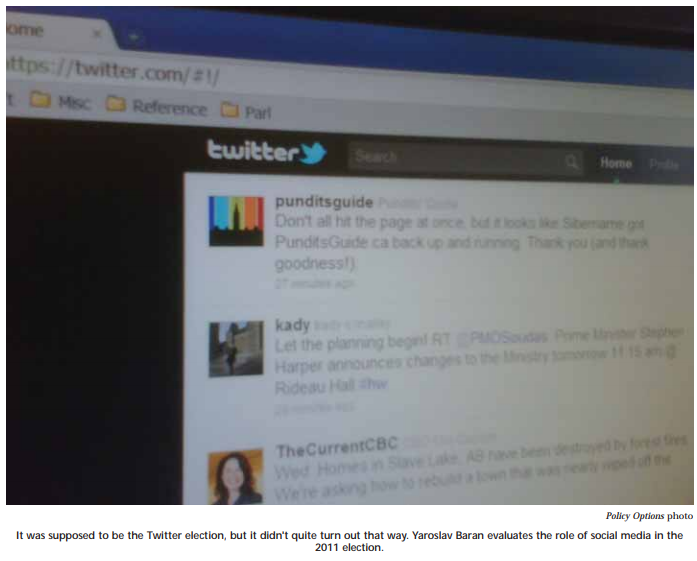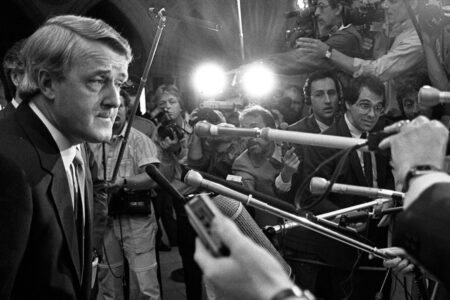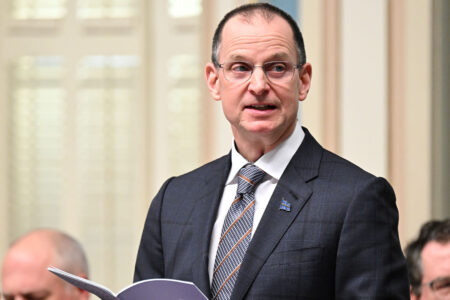
The 2000 campaign was the first election when everyone had a cellphone. Imagine that: instantaneous communication between all campaign team members and candidates! In 2004 it was the BlackBerry Election — just as big a deal. There would be no more reliance on hotel filing rooms and check-ins for travelling campaigns (political teams and journalists alike) to reconnect with the world. The 2006 election saw the advent of blogging as a non-”media” medium — everyone could now be a columnist, and compete with the “real” ones for commentary space on the Web. In 2008 we had the YouTube Election: post your own ads — or if you’re a political party, you could get free circulation for your product, and save on ad buy, by going viral! Every federal election seems to have a critical new innovation — a new medium hailed as a game changer in the way the political community communicates with the mass political consumer market. And 2011 has been called the Twitter Election.
Even before the election campaign began, Twitter was hailed as the revolutionizing feature of the coming writ period — instantaneous communication, unfiltered. It was the Great Democratizer: a new medium that allowed — encouraged — candidates, political operatives, journalists and commentators to communicate immediately, without official filters, and without the use of official mouthpieces, be they press secretaries or press releases. A new age was dawning in which party control and censorship would be a thing of the past — a relic consigned to the dustbin of history, along with Brylcreem and the Soviet Union.
So how did it all work out? What did Twitter do to the Canadian federal election campaign of 2011? Has the vox populi of the great microblogging phenomenon shattered the barriers of traditional political communication and redefined the relationship between media and politicians in the same way Johannes Gutenberg catalyzed a new era of thought dissemination?
While it certainly had an impact — even a significant one in some respects — a fair analysis would have to conclude that Twitter’s influence was primarily in creating a new platform through which the political class could speak with itself, just more quickly. Even in the areas — to be explored further in this article — where it did change the way “we” do things in elections, the “we” continues to be defined as primarily the political class of candidates, party organizers, spin doctors, journalists, commentators and political analysts. “We” were talking to each other through a new medium. It hardly touched the public. Where it did, it was primarily a broadening of the political class to a large new outer ring of partisan, or more highly politically aware, members of the public whose political opinions are more likely to be pre-established. Revolutionary — in a macro sense — Twitter was not.
The statistics can be impressive, depending on how you look at them. Canada is one of the most proportionally tweeted-up countries in the world, with more than 3 million users. But flip that statistic upside-down, and consider whether television or newspapers could be justly called a revolutionizing political medium if they remained inaccessible to more than 90 percent of the population. Regardless of access and uptake, however, my overall observation of Twitter’s use by the political class during this election campaign (#elxn41 in Twitterspeak) was that the same people were saying the same kinds of things, and pushing the same kinds of products as before, to the same people — still inside the bubble.
So how, then, did Twitter make a difference to the election campaign?
Impact number one: a new platform.
The most obvious influence of the new medium is just that: it was a new medium. Twitter has quickly become a quick and efficient platform for dissemination of messaging. In my own tenure of managing political press offices over the past decade, I have watched the evolution from fax machines to e-mail as the primary vehicle of press release delivery. Microblogging has taken this to the next step with a rapid, efficient (in time and cost) and more highly targeted dissemination. In days past, newsrooms received inches and inches of paper press releases rolling off their fax machines. More recently — and still largely the case — press releases have cluttered up the e-mail in-boxes of news editors and reporters alike. In this regard, Twitter allows for targeted dissemination, in that headlines and hyperlinks are sent specifically to those reporters — and members of the public — who have specifically subscribed to them from the official “handles” of the various parties. Spam will decrease as uptake — and more full transition to this delivery mechanism — increases.
For reporters, it has also proven to be an efficient vehicle of dissemination in a highly saturated and competitive news market. Reporters routinely now tweet headlines or “ledes” with accompanying hyperlinks to full stories. No longer do reporters have to wait for the first edition to come out. A story can be broken instantly, relying only on the prowess of the news organization’s Web editors to post new stories promptly. That said, the innovating feature is still largely the growing influence of the Internet as a news medium — not necessarily the tweet that draws attention to it.
So overall, the verdict on impact number one: Evolutionary? Surely. Revolutionary? Not quite.
Impact number two: speed. With a 140-character limit per posting, Twitter cuts down dramatically on the time required for formulation of thought, allegation or rebuttal. It has to be tight. Whereas responses to high-profile allegations had previously taken hours (getting the press release just right, vetted by multiple eyes), a tweet can be instant, even if it is initially just used as a paceholder to indicate that one is in the game, with additional information to come later: “This allegation is false. More to follow.” Crisis communication is taken into real time.
Reporters also benefit from the speed and Wiki-like access to the Twitterverse. By appealing to one’s followers, they can cut down on countless hours of research: “Anyone remember date of Dief’s first budget?” or “When does Elections Canada’s poll reporting blackout go into effect?” Chances are, someone will know off the top of their head. Moreover, the instant sounding board can give a quick green or red light to a story perspective. As one journalist noted, he can go to the “hivemind” with his take on a breaking story and say, “Does this make sense?” The efficiency alone is a powerful tool.
One obscure reporter breaking a tidbit of news from one corner of the country can find her news repeated and retweeted instantly, until it bounces through the Twitterverse directly into the public consciousness of the entire political class.
Impact number three: oxygen for a developing story.
Twitter, through its speed and reach, has led to another significant impact on election campaigns, albeit an extension of what Twitter has already done for news-worthy events generally — it allows them to grow almost instantly into a “story.” One obscure reporter breaking a tidbit of news from one corner of the country can find her news repeated and retweeted instantly, until it bounces through the Twitterverse directly into the public consciousness of the entire political class. The instant commentary on such breaking events also feeds the perception that a story has legs, or is growing into something bigger than first thought, potentially requiring crisis control by an interested party.
One example of this phenomenon is the tweet by Prime Minister Harper during the leaders’ debate design period, suggesting that a one-on-one between him and Michael Ignatieff might be a suitable idea. Ignatieff’s “anytime, anyplace” response instantly turned a musing into a story — and subsequently a controversy. The Conservative war room spent days later trying to explain that it was floated as a potential alternative to an all leaders’ debate, but that an additional one-on-one was not in the cards. Predictably, this resulted in the bluster and rubber chicken masks dogging the Conservative campaign tour for nearly a week. An off-the-cuff tweeted idea became an “issue” to be managed.
Is this new, however, or have mass communication, the 24-hour news cycle, and media consolidation and platform integration already been contributing to this oxygen phenomenon? In fairness, one would have to conclude that the oxygen phenomenon was already there, and Twitter just gave it a little more…well, oxygen.
I would also add that the last election campaign was in fact remarkable for its low number of Twitter gaffes — careless “brain cramps” for which candidates were later forced to apologize, or from which leaders were forced to distance themselves. Despite the immense political hazard of a mass communication platform designed for unfiltered spontaneous commentary, candidates across the spectrum revealed an impressive maturity, restraint and responsibility in its use.
Moreover, insofar as Twitter did in and of itself instantly mushroom stories, the “bubble” audience of those commenting on political stories can delude journalists and politicians alike that the real world actually cares about the controversy at hand. How many votes were changed by the expulsion of two people from a Conservative rally, or by the story of an unauthorized advance polling station at the University of Guelph? I am guessing not too many. But in the Twitter coverage of the election campaign, they were major events — dare I say, scandals. This new medium does, therefore, reinforce the need for message discipline by political parties. Woe to those who stray from their ballot question to chase a microblogging-hyped “story” that the real world may not care about in the least — or will not have even heard about.
Another significant impact of Twitter — albeit primarily significant only to the small subset to whom this matters — is the blurring of the distinction between the “reporter” and the “columnist.” By traditional definitions, they have distinct job descriptions: reporters report the news; columnists editorialize on it. Perhaps because of the casual nature of social media, however, it seems reporters are increasingly comfortable tweeting their own opinions in an instantaneous fashion about the events they are tracking.
A candidate standing for election now has the advantage of glimpsing behind the mask of the person who has just approached them for an interview, to gauge any predispositions — helpful or unhelpful — that may help determine whether to grant the interview. Similarly, individual consumers of the “news” now increasingly have an opportunity to assess the reporters delivering them the news.
By no means is this observation intended as a criticism of reporters. Indeed, it is a refreshing reminder that they are people — with opinions and occasionally with axes to grind. But for the politico facing the reporter, it is useful to see what those opinions and axes are. Veteran political observer David Herle recently opined that “social media are the water cooler of our time.” Indeed they are. But traditionally, reporters were not the ones publicly musing aloud at the water cooler. Now they do just that in increasing numbers.
But perhaps the most significant structural impact that Twitter had on the election campaign — and an influence derived from the aforementioned phenomena — is what it did to political “spin”: it put spin on speed.
As veteran columnist (and prolific tweeter) Andrew Coyne noted on the day of the first leaders’ debate,
Reporters used to talk about the “spin room” at events like debates, where strategists would try to pitch their version of what just happened. I suppose there’s no need for them now: it all happens on Twitter. Twitter has become the modern spin room. We (journos) even help them spin us. Previously, pols would have had to guess what we were thinking, until the piece appeared — then react. Now they can spin us in real time, while we’re gathering — & disseminating — our thoughts. Mind you, we can also catch & correct mistakes before they hit print, sometimes with the spinners’ help. (They do offer facts, too.) It’s a collective, constantly recalibrating ever-correcting process, where once it was conducted in separate corners, individually.
As a tiny bit of irony, I note that it took him 10 tweets to post his comment, but the observation is astute. The news-making, news-reporting, news-reacting, news-revising process is no longer sequential. It’s simultaneous. While the physical “spin room” still existed after the #elxn41 debates — with two representatives of each party giving “first response” to the journalists covering the debates on site — that reaction was no longer “first response.” By the time those conversations occurred, the media covering the debates had already endured two hours of real-time spin and counterspin from the wider political class.
Similarly, a number of politically conscious friends and colleagues have noted that they did not even bother watching the debates on television. They followed them on Twitter, thereby getting not only the content, but also the real-time analysis from a variety of commentators — media and non-media alike.
So the medium has had an impact. Some — the hyperpaced journalist or the news-voracious politico — might even claim that it has irrevocably changed the way the political class engages in the business of communication. But that is precisely the point. It affected them — the bubble. It impacted primarily those who are already professionally engaged in politics and political reporting, or those who are more politically conscious — therefore more predisposed to having an entrenched political opinion. Despite its various influences on political discourse, Twitter’s entrée into the electoral realm has really been the political class talking to the political class.
Veteran columnist Dan Gardner characterized it as “group-think on steroids — passing information and group-think more efficiently.” Himself a prolific tweeter, he acknowledges that “it’s a conversation inside a bubble. If you’re not inside the bubble, you don’t even necessarily understand what they’re saying.”
The pre-election hype foretold of Twitter shattering Berlin Walls of political communication and changing forever the way politicians and journalists interface with the masses. It didn’t happen. Things changed; they always do from election to election. This is a fact of life in a technologically innovative age. But it was perhaps the Twitter political bubble that in fact convinced itself — inside that same bubble — that this medium would be the revolutionizing feature it failed to be.
In week three of the election campaign, I received a Twitter response in reply to one of my own (Conservative friendly) tweets. It came from a Liberal supporter: “You guys are going down. We are KICKING your ass in Social Media!” You know what? Perhaps they did kick our ass in social media…but how did that turn out for you? We may one day get to that revolutionizing social media impact on election campaigns, but we’re not there yet. Not even close.
Photo: Shutterstock







